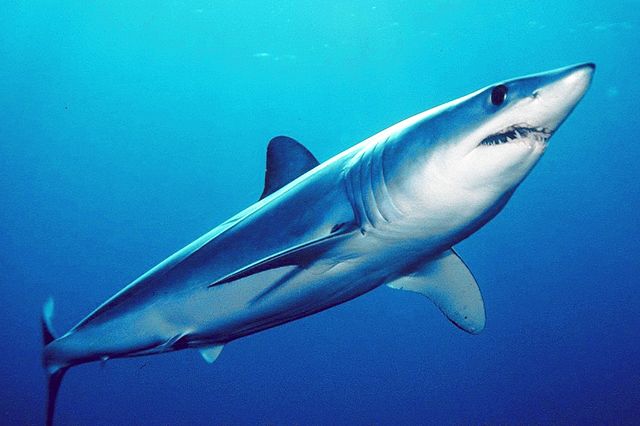Species Spotlight: Top 10 Sharks of the Pacific Northwest
May 11, 2023
For 450 million years sharks have been roaming the ocean. The harsh waters of the Oregon Coast are no exception, with some of the most unique and awe inspiring species of sharks making their home in our great state. In the seventh installment of species spotlight, let’s dive into the fascinating world of sharks in the Pacific Northwest.
Salmon shark
The salmon shark is just a little guy, but frankly not much more. At six to eight feet in length they definitely are on the smaller end of this list. They are related to the great white shark, and are almost a pocket sized version of the iconic species. The most interesting thing about this shark is the fact that it can maintain homeothermy, which means that it can dive deep underwater and provide its own heat. Overall, pretty cool, but not interesting enough to make it high on this list.
Catshark
Catsharks are silly little guys with a quirky genetic makeup. They get to about five feet long at most, and are covered in cute polka dots. This species of shark are poor swimmers, and often sleep all day in little crevices they find, almost like cats! The catshark has something called the “Sonic the Hedgehog” gene in its jaw, which is how it replaces its teeth every 18-38 days. At the end of the day, this is just a funky looking cat to me, but I’m all for it.
Leopard shark
Leopard sharks are a non-aggressive species of shark reaching about three to five feet in length. They are easily identifiable because of the giant stripes and spots running down their back. Even though the sharks are mostly gray, they are probably the most beautiful shark on this list because of their intricate patterns. Leopard sharks eat in a unique way; like a little vacuum, the leopard shark grabs prey by creating a strong suction force with its mouth and then securing its prey with its teeth. The leopard shark also quickly glides along the ocean floor. Thus, this shark species is the prettiest roomba on earth.
Pacific angelshark
The Pacific angelshark is the most unique addition to this list. Its appearance is stunning; almost resembling a ray, the pacific angel shark is five feet long, flat as a pancake and covered in little polka dots. It glides around in shallow waters looking for victims. As an ambush predator, this shark will lie low, blending in with the surrounding ocean floor until it sees its prey. Then, it will snap its neck up and grab the prey when it least expects it. Overall, quite an intriguing shark.
Broadnose sevengill shark
The broadnose sevengill makes it onto the list for a few key reasons. First and foremost, it is noted for having seven gills whereas most sharks only have five. This is because of the shark’s relatives from the Jurassic Period. 145-200 million years ago sharks had seven gills, meaning these sharks are related to dinosaurs! The second reason it’s on the list is because I like its nose. It makes the shark look like a little blob, with no thoughts going on in its head. Adorable.
Great White shark
Listen, the Great White is awesome; always has been, always will be. It is around 15 feet long, an apex predator with barely any known predators, it has a bite force of over 4000 lbs, the list goes on. However, it’s overdone! Great whites are all anyone ever talks about, and frankly the narrative tires me. We have to move on here, folks, there are better sharks out there. So while I recognize the prestige, I can’t conscionably put it any higher on the list.
Bluntnose sixgill
Growing to about 16 feet long, the bluntnose sixgill shark has prehistoric genes. Much like the sevengill shark, this shark has more gills than the average shark. My favorite feature of this shark is its nose. The bluntnose has a very rounded, small snout and a ridge on top of its head. These features give the impression that its face is smushed into its neck. The last thing that’s interesting about this shark is that it has “positive buoyancy,” meaning that it can swim upwards faster than downwards. This allows the shark to glide along the ocean floor, quickly strike its prey. Pretty solid shark overall.
Shortfin Mako shark
The shortfin mako shark is smart, big and beautiful. It reaches around 13 feet in length, and has a distinct blue coloration. I am a really big fan of this shark’s look; it is vibrant and streamlined, exactly what you think of when you hear “shark.” Additionally, female shortfin makos are larger than the males: #girlboss. Researchers have also found that shortfin mako sharks have a large brain to body ratio, and are incredibly smart. This species has it all, and easily deserves a high placement on this list.
Basking shark
Two words: BIG BOY. The second largest shark species in the world is living right off our coastline! The basking shark can get up to 26 feet in length, and has a unique style of feeding called filter feeding. This species opens up its giant mouth and slowly swims around. It filters out water through its gills and lets fish just swim into its mouth. This shark isn’t aggressive, it’s just a big chill guy who isn’t a picky eater. Fun fact, basking sharks can be mistaken for abnormally large great whites because of their similar silhouette.
Spiny dogfish shark
Our world has long thought that a pursuit of “perfect” is fruitless, that for something to exist flawlessly was impossible. However, I would argue that the spiny dogfish shark is the exception, shining a light through the vast and uncaring expanse of the cosmos. There is quite literally nothing I would change about this species. There isn’t a map in existence that could stop me from getting lost in its giant, mesmerizing eyes. There isn’t a thing I wouldn’t give to see packs of spiny dogfish reaching into the thousands cutting through the ocean waves. The spiny dogfish’s shimmering three foot frame is even topped with venomous spines on its back to help defend itself from predators. I can’t think of anything more beautiful.
Unlike some other editions of Species Spotlight, I have to encourage you NOT to go looking for sharks off the coast. However, this review hopefully helps you admire from a distance, giving you a start to exploring one of Oregon’s most unique and infamous animals.




Aila • May 16, 2023 at 10:23 am
my boy the leopard shark got robbed. justice for the roomba 🙁